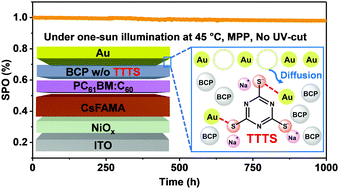Inhibiting metal-inward diffusion-induced degradation through strong chemical coordination toward stable and efficient inverted perovskite solar cells†
Abstract
The inward diffusion of metal electrodes is one of the main reasons for the deterioration of the long-term device stability of perovskite solar cells (PSCs). Thus, herein, we adopt a simple additive engineering strategy to modify the barrier material bathocuproine (BCP) with 1,3,5-triazine-2,4,6-trithiol trisodium salt (TTTS). Different from the traditional physical blocking strategies, TTTS could prevent the metal electrodes (e.g., gold, silver, and copper) from diffusing inward through the strong chemical coordination between TTTS and the metal electrode. The TTTS additive also improved the conductivity and band structure of BCP, thus enhancing the ability of BCP to extract electrons from the perovskite layer to the electrode. Consequently, the inverted device modified with TTTS exhibited a high efficiency of 22.59%, which is among the highest efficiencies reported to date for inverted PSCs. More importantly, it showed excellent operational, ambient, and thermal stability. The target device maintained its initial efficiency with no loss under continuous one-sun illumination at maximum power point tracking after 1000 h (the champion device), 91% in air (50% ± 5% RH) for 5000 h, and 93% after heating at 85 °C for 1500 h (average efficiency from ten devices).



 Please wait while we load your content...
Please wait while we load your content...